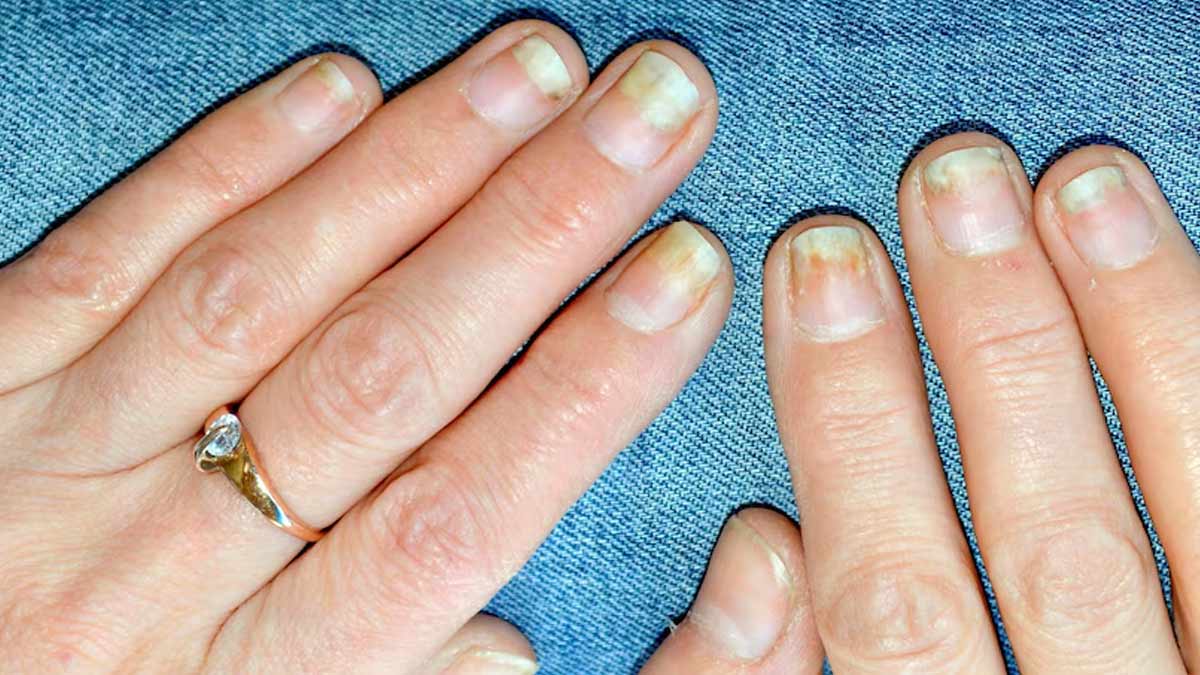
Your nails are often one of the most overlooked parts of your body, but they can serve as important indicators of major health issues. For example, nail psoriasis is an autoimmune condition that specifically affects the fingernails and nails. On the other hand, nail fungus is a common infection of the nails. Both conditions share symptoms like discolouration, cracking, and nail separation from the nail bed, which can make it challenging for individuals to distinguish between them.
Table of Content:-
In an interaction with the OnlyMyHealth team, Dr Geetika, Dermatologist and founder of Influennz Skin and Hair Clinic, shares key characteristics of both conditions along with management tips.
Also Read: Nail Care For Diabetics: Follow These Tips To Maintain Healthy Feet and Hands
What Is Nail Psoriasis?

The National Institute of Arthritis and Musculoskeletal and Skin Diseases describes psoriasis as a chronic disease in which the immune system becomes overactive, causing skin cells to reproduce quickly. Unfortunately, psoriasis can affect different parts of the body, including your nails.
According to StatPearls Publishing, it can affect both adults and children, and males and females equally. Given that psoriasis has different types, nail psoriasis, in particular, is associated with cutaneous psoriasis and psoriatic arthritis. In fact, research suggests that there is an 80-90% association between nail psoriasis and psoriatic arthritis.
What Is Nail Fungus?
Nail fungus, also known as onychomycosis, occurs when nails get infected with fungus. These include dermatophytes, yeasts, and saprophytic mould infections.
According to another article published in StatPearls Publishing, the most common cause of onychomycosis is Trichophyton rubrum. However, other dermatophytes, including Trichophyton mentagrophytes and Epidermophyton floccosum, can also cause it. The dermatophytes are identified in 90% of the toenail and 50% of fingernail onychomycosis, the research notes, adding that candida albicans cases account for 2% of nail psoriasis, especially in fingernails.
Key Symptoms Of Nail Psoriasis Vs. Nail Fungus

Both nail psoriasis and nail fungus can cause similar symptoms, such as:
Nail discolouration: Affected nails may turn white, yellow, brown, or green. The discolouration often starts at the edge of the nail and spreads inward.
Nail dystrophy: The infected nail may become thickened, brittle, and deformed, making it difficult to trim and causing discomfort when wearing shoes.
Nail psoriasis may have other key characteristics. These include:
- Nail pitting
- Onycholysis, or the separation of the nail plate from the nail bed, starting from the tip of the nail
- Thickening of the skin under the nail
- Nail crumbling, or disintegration, particularly at the edges
- Leukonychia, or the presence of white lines or spots on the nail plate
- Red or brownish streaks under the nail that resemble splinters
Also Read: Wishing To Have Nail Longs? Try These 7 Ways To Fasten Your Nail Growth
How To Distinguish Between Symptoms Of Nail Psoriasis And Nail Fungus
While both nail psoriasis and nail fungus can cause nail discolouration and deformation, there are some key differences between the two conditions. These include:
Symmetry: In nail psoriasis, all nails tend to be symmetrically involved due to the internal, systemic nature of psoriasis. In contrast, nail fungus typically affects a few nails, as it is caused by an external infection.
Psoriasis lesions on the skin: The presence of psoriasis lesions elsewhere on the body strongly indicates that the nail changes are due to psoriasis rather than a fungal infection.
How To Confirm What You Have?

For an accurate diagnosis, it is crucial to undergo certain tests that can help detect whether you have nail psoriasis or a fungal infection of the nails. Some of these tests include:
- KOH Test, a potassium hydroxide (KOH) preparation of nail scrapings that can reveal fungal elements under a microscope, confirming a fungal infection.
- Periodic acid-Schiff (PAS) staining of nail clippings is positive in fungal infections and negative in nail psoriasis.
- Fungal culture, or growing the fungus in a lab from a nail sample, can confirm the presence of a fungal infection, which is not seen in psoriasis.
Nail Health Tips
Maintaining nail health is extremely crucial, regardless of whether or not you are dealing with nail psoriasis or simply want to maintain healthy nails. Here are some tips to maintain overall nail health:
- Keeping nails well-groomed and manicured to prevent issues like ingrown nails and reduce the risk of infection.
- Avoid nail biting, as it can damage the nail bed and introduce bacteria or fungi.
- Regularly moisturising your hands and nails to prevent dryness and cracking
- Limiting prolonged exposure to water and always drying nails thoroughly after washing.
- Keeping the cuticles hydrated
[Disclaimer: This article contains information provided by an expert and is for informational purposes only. Hence, we advise you to consult your own professional if you are dealing with any health issues to avoid complications.]
Also watch this video
How we keep this article up to date:
We work with experts and keep a close eye on the latest in health and wellness. Whenever there is a new research or helpful information, we update our articles with accurate and useful advice.
Current Version